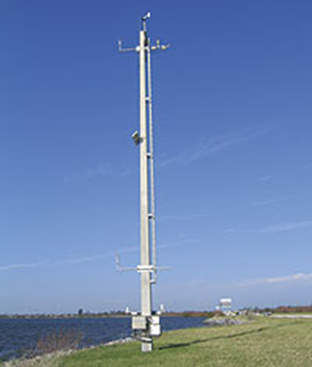
Road Network Operations
& Intelligent Transport Systems
A guide for practitioners!

Road Network Operations
& Intelligent Transport Systems
A guide for practitioners!
Driving can be heavily affected by adverse weather conditions, such as heavy rain, high winds, dust storms, snow, fog and icy roads. It is important to inform drivers of extreme weather conditions in advance so they can change their travel plans or proceed with caution. Warnings on conditions that may be hazardous – such as high winds, icy roads or torrential rain – are especially helpful.
Road Weather Management (RWM) strategies provide:
For these purposes, supporting technologies include:
In adverse weather conditions, any intervention by the road operator must be implemented and co-ordinated efficiently to maintain the viability of the road network. In a flooding situation, for example, it is necessary to determine back-up solutions for the provision of driver information in the event of power or telecommunications failure. Procedures should include identification of areas at risk of flooding, the implementation of real-time monitoring systems incorporating threshold alarms and the specification of operations on receipt of alarm.
Post-emergency phases are equally important and include:
A successful RWM programme requires both prevailing and predicted weather and traffic information. The data required to derive this information needs to be collected from multiple sources. Many road authorities (as well as other industries) subscribe to commercial weather forecasting companies that provide timely, location-specific forecasts. They can do this because they draw their data from multiple sources, including the weather services – and integrate the results. Some have their own forecasters available on call to clients for consultation.
A self-evaluation and planning guide was developed, as part of an Federal Highway Administration study in the USA on integrating weather into TCC operations. The aim was to help TCCs evaluate their weather integration needs and develop appropriate implementation strategies. The guide assists the TCCs to identify weather conditions, weather impacts – and current levels of weather integration in the TCC and the need for enhanced integration.
In countries prone to severe winter weather, preventive action and crisis response may consist of handling both major disruptions to traffic (often lengthy) and frequent but brief disruptions due to weather conditions such as freezing rain, black ice or snow. The network management objectives will be to:
Winter service is based on data gathering (forecast and real-time), coordination, response and information dissemination. It requires a thorough knowledge of the network and its critical points, specific weather information, a sound knowledge of all stakeholders (such as weather forecasting services, suppliers of de-icing material), trained staff, equipment and materials (such as salt) – and good communication tools.
Traffic operations understandably deteriorate when there are inclement weather conditions. Automation of data collection of such conditions enables facility managers to respond to adverse conditions more timely and efficiently.

A Road Weather Management (RWM) system (also known as Road Weather Information Systems (RWIS) and Weather Responsive Transport Management Systems (WRTM)) - consist of a set of sensors or Environmental Sensor Stations (ESSs) (See Weather Monitoring). These weather stations can detect and report a number of environmental measures that affect roadway operations, such as:
Perhaps the most common use of RWM is in cold climates and/or mountainous regions where snow and ice are commonplace. Maintenance operators use the data from strategically placed ESS units to determine the optimal time to deploy dispensing trucks for salt and grit and snow ploughs – and to determine the best treatment strategy – such as whether to use brine, salt or sand. This helps avoid premature or incorrect deployments, saving valuable materials and minimising vehicle operating cycle times, as well as reducing environmental impact.
Maintenance staff frequently use fleet-management systems to locate their vehicles, including where they have and have not yet ploughed or treated. In many regions, weather conditions can vary considerably from place to place. RWM may be used to help prioritise where and when to send equipment.
RWM technologies are also used to detect conditions that may be hazardous (such as high winds or flooding) – or that may impact roadway operations. Sensor systems are used to detect other conditions that cause reduced visibility – such as fog, smoke, blowing dust or sand and blizzard (white-out) conditions on roadways.
Wind-speed sensors on exposed roadways and bridges alert TCCs about when they should consider issuing travel advisories for trucks and other large vehicles. When wind speeds are particularly high it may be necessary to impose a maximum speed and in some cases close the bridge to all traffic.
Water-level sensors can alert managers when floods are threatening, particularly for flash-floods in normally arid climates or in built up areas when streams and rivers overflow.
Road operators should ensure that drivers, travellers and other stakeholders (such as public transport operators, school bus and ambulance services and control rooms for delivery and haulage operations) have access to timely, accurate and relevant information on current and forecast road and weather conditions. All forms of traveller services can be used to disseminate messages on snow, ice, rainfall (precipitation), visibility, wind and extreme weather events using VMS, HAR, websites, 511 traveller information systems and other methods. (See Traveller Services)
Integrating weather information into TCC operations allows the development and use of decision support to better manage the traffic under adverse conditions, to dispatch maintenance crews and respond appropriately and in a timely manner to weather-induced problems. Decision support built on integrated weather and traffic information into traffic analysis tools and TCC operations allows more proactive – rather than reactive – management. (See Planning and Reporting)
This adds value to road operations because it makes the actions needed to mitigate adverse weather more efficient – maintaining traffic flow in as orderly a fashion as possible under the circumstances.